Helping Haiti: Local Disaster Relief Team Visits Part I
March 6, 2010
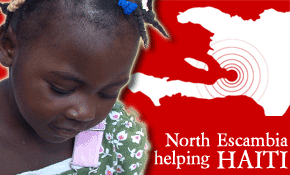 Today we begin a three-part series “North Escambia: Helping Haiti”. We will take you to Haiti through the eyes of two area men that just returned from a disaster relief mission. We will hear about their work in Haiti in their own words, and we’ll see the country through their eyes via their photographs. We will also look at how you can be a part of the effort to provide relief in the earthquake ravaged country.
Today we begin a three-part series “North Escambia: Helping Haiti”. We will take you to Haiti through the eyes of two area men that just returned from a disaster relief mission. We will hear about their work in Haiti in their own words, and we’ll see the country through their eyes via their photographs. We will also look at how you can be a part of the effort to provide relief in the earthquake ravaged country.
Today, in his own words, Sonny Davis from Hillcrest Baptist Church describes his recent Pensacola Disaster Relief team visit to Haiti. Sunday morning, we will learn more about the trip from Drayton Smith of the First Baptist Church of Cantonment. The photographs that accompany this article were taken by Smith in Haiti.
 The Pensacola Disaster Relief team consisted of two chaplains and two assessors — Sonny Davis, Doug Dickerson, and Scott Baisden from Hillcrest Baptist and Drayton Smith from First Baptist Church of Cantonment. Because the Port-au-Prince airport was stilled closed to commercial traffic at the time of our departure, we flew from Pensacola to Santa Domingo, Dominican Republic.
The Pensacola Disaster Relief team consisted of two chaplains and two assessors — Sonny Davis, Doug Dickerson, and Scott Baisden from Hillcrest Baptist and Drayton Smith from First Baptist Church of Cantonment. Because the Port-au-Prince airport was stilled closed to commercial traffic at the time of our departure, we flew from Pensacola to Santa Domingo, Dominican Republic.
There, we were met by Doug Roberts, IMB missionary. Doug and his wife were our hosts at the mission house in Santa Domingo. When ground transportation could be arranged, we traveled by bus from Santa Domingo to Port-au-Prince. Accommodations were provided at the FL Mission House, which can hold about 55 people. The Mission House receives power from a generator and has running (although not hot) water. The generator is used to pump water from a well to a large cistern on the roof. Water is then available via gravity for showers and toilets. With that many people staying at the house, the cistern could not hold enough water for everyone to take a shower at once. Those arriving back to the mission house later than others would often have to wait at least an hour to repeat the process of filling the rooftop cistern.
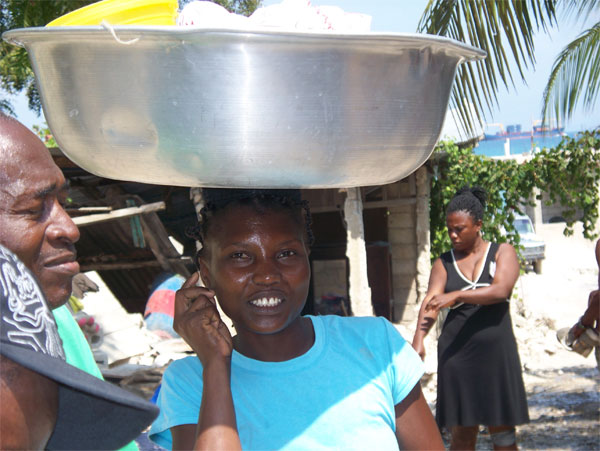 Each morning, our team of four would be assigned to a Haitian pastor, an interpreter, a security person and a driver. Each pastor wanted his church building inspected first, then we would move on to members of his congregation, and further into the community. If the church was determined to be safe, it was then a viable location for a future medical clinic to be staffed by DR medical teams.
Each morning, our team of four would be assigned to a Haitian pastor, an interpreter, a security person and a driver. Each pastor wanted his church building inspected first, then we would move on to members of his congregation, and further into the community. If the church was determined to be safe, it was then a viable location for a future medical clinic to be staffed by DR medical teams.
Maneuvering between houses down narrow lanes was a challenge for even our experienced drivers. Debris littered the streets, and tents were set up in almost any empty space. There are only a few street signs or house markers, so we used portable GPS units to mark the location of each structure that we inspected. Most of the structures that we inspected the first two days were habitable; although almost all needed some sort of repair.
The people have very little money for repairs. For those who did have livable homes, it was more difficult to convince them to sleep inside that it was to do the actual inspection. Each family was pleased that we were there and welcomed the prayers that we offered before moving on to another location. For those of you who have been to third world countries, you are probably familiar with seeing homes constructed primarily of concrete and blocks. No building codes are in effect, and construction materials are inferior; consequently, homes with concrete roofs were more susceptible to destruction than those with tin roofs. There is virtually no glass for windows, almost no running water, and little use of electricity. Many of the homes look like they were built in the 1950s. Some had plumbing fixtures, but they were no longer in use due to the lack of a working water system. Most families had access to a nearby well.
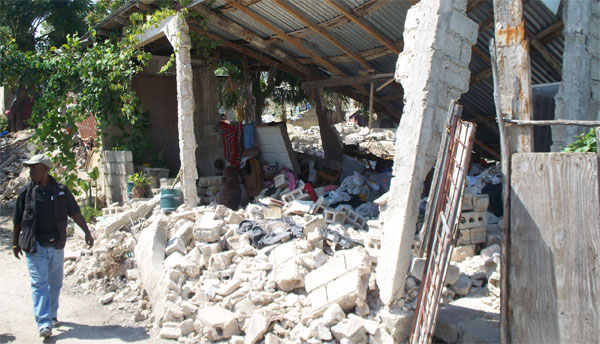 The Haitians buy food and a crude form of charcoal daily and cook on small grills that resemble hibachis. They cook in a small room on the outer edge of the house. Food was being cooked in nearly every home; however, the quantities were always small. Women and girls wear dresses, and men wear long pants. This seems to be a cultural practice, not a religious requirement. The Haitians we visited were clean and had clean clothes, despite having only a kitchen wash pan to bathe and wash their clothes in. None of the families that we visited on the first two days of our adventure had experienced any loss of life in their homes. They all had family members that had been injured or died in the area.
The Haitians buy food and a crude form of charcoal daily and cook on small grills that resemble hibachis. They cook in a small room on the outer edge of the house. Food was being cooked in nearly every home; however, the quantities were always small. Women and girls wear dresses, and men wear long pants. This seems to be a cultural practice, not a religious requirement. The Haitians we visited were clean and had clean clothes, despite having only a kitchen wash pan to bathe and wash their clothes in. None of the families that we visited on the first two days of our adventure had experienced any loss of life in their homes. They all had family members that had been injured or died in the area.
On Sunday, we attended Pastor Joe’s church. His was one of the first churches that we inspected. Even without musical instruments, the church produced a beautiful harmony while singing hymns in Creole. Pastor Joe preached, and an interpreter helped us understand what he said, then Drayton preached and the interpreter helped the congregation understand, and then Pastor Joe preached again. In all, the service lasted almost three hours. Their “pews” were the narrowest, wooden benches that I have sat on. After the service, LA DR volunteers set up a medical clinic and saw close to 300 patients. Most of the patients suffered from respiratory illnesses, high blood pressure, or infections. Many wounds also needed redressing. The people were appreciative and friendly both in the clinic and in the homes we visited. We were surprised by the number of Haitians that spoke some English, but not nearly enough spoke English to allow us to do without the interpreter.
On the last three days of our visit, we traveled with Pastor Pierre for about an hour and a half to the outskirts of Port-au-Prince in the back of a small truck. The truck had been outfitted with wooden benches on both sides of the bed. It also had a raised camper shell with open sides allowing air to flow through, but providing some protection from the elements. Vehicles of this manner are called tap-taps; the Haitian version of a taxi. Our security man always sat on the rear corner of the truck to keep residents from jumping on for a ride. This area had suffered a lot more damage. Very few homes did not suffer significant damage or were totally destroyed. Several families had lost members of their immediate family or close neighbors. It was difficult to tell the people that their home should be torn down.
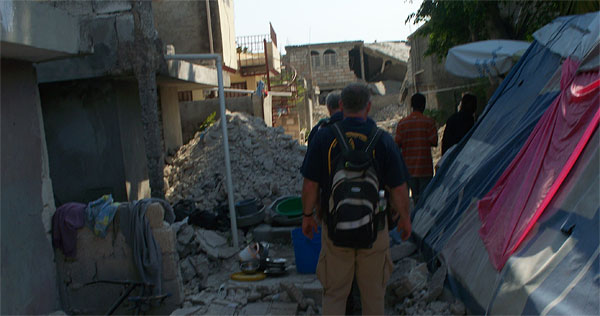 Our job was to inspect and make notes about needed repairs; it was not to make actual repairs. We assured the people that many Christians in the United States were praying for them. We hoped that others would come to help with repairs, although we could not promise that. Often, our prayers were the only hope or comfort we could offer. While inspecting a house in that area, we led five girls and a boy to the Lord, ages 5 – 13. One lady, however, refused to get saved because she said her clothes weren’t good. The pastor promised to go back and visit with her again.
Our job was to inspect and make notes about needed repairs; it was not to make actual repairs. We assured the people that many Christians in the United States were praying for them. We hoped that others would come to help with repairs, although we could not promise that. Often, our prayers were the only hope or comfort we could offer. While inspecting a house in that area, we led five girls and a boy to the Lord, ages 5 – 13. One lady, however, refused to get saved because she said her clothes weren’t good. The pastor promised to go back and visit with her again.
Later that same day while we were inspecting a church, Drayton led sixteen more people to Christ. The next day, seven additional Haitians were saved. Before agreeing to pray, most of the women would find a scarf or handkerchief to cover their heads. Those with bare arms would put on another shirt or wrap a towel around themselves before praying. What a blessing it was to see people eager to come to know Christ. Isn’t it true that tragedy often prods people, no matter where they live, to re-examine their lives? In total, our team inspected 7 churches and over 50 homes. Although the people we visited welcomed us with open arms, Haiti remains a very dangerous country. Our security guard kept a watchful eye on us constantly. He made sure that he stood between us and any possible confrontation. Only women are allowed to stand in line for food. The government is trying to prevent riots by excluding men from food distribution lines.
The Haitian people are very poor; the work to be done is overwhelming; and the Haitians need help to rebuild their lives and their country. Many relief agencies are visible in the country now, but FL Baptists will remain in Haiti long term. The FL Baptists were there for 15 years prior to the earthquake, and they plan to be there indefinitely. Through the efforts of FL Baptists almost 900 churches in Haiti have been established that are now led by Haitian pastors. Since the earthquake 40,000 people have come to know Christ through DR volunteers, Haitian pastors, and a 3-day call to prayer and fasting. The five year vision of the Haitian pastors is for an additional 1.5 million Haitians to come to know Christ. Through your financial help, your prayers, and your time as a volunteer this is possible.
Photos by Drayton Smith, First Baptist Church of Cantonment, for NorthEscambia..com, click to enlarge.
Comments
5 Responses to “Helping Haiti: Local Disaster Relief Team Visits Part I”



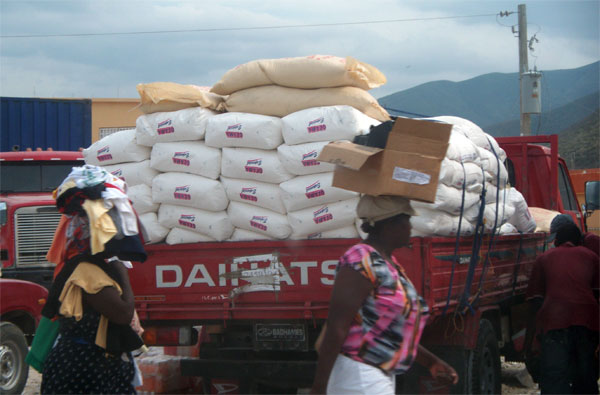
Thanks for the work that you do. I have to say a special “thank you” to the many Baptist’s who step up to the plate when there is a crisis and who always seem to be some of the first to do so. I have experienced homelessness myself, and my help came from many Baptist neighbors, who were there in my time of need to offer whatever they could.
I know there are many organizations and individuals who are also helping the Haitians. May God bless your lives as you continue to reach out.
Thanks so very much!
I am very proud to see this. I grew up in Pensacola but I am now working for the Washington Post. It will take many efforts to rebuild Haiti. My dad used to work at Champion paper in Cantoment. I graduated from Woodham in 1978
great story….glad that you are covering this!
Thanks for bringing us this story. It’s always nice to hear what locals are doing across the globe to show the love of Jesus and lead others to Him. Great testimonies of God’s provision usually come in the midst of complete devastation.
When disaster strikes and it looks like no hope God is always working at his best.